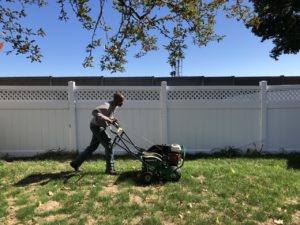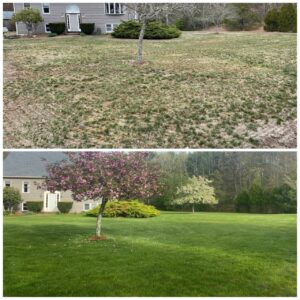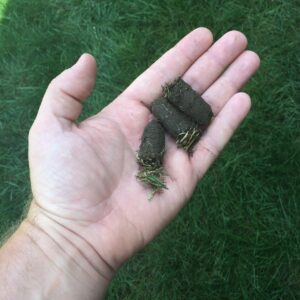Here at Lawn Doctor, fall means one very important thing: seeding! Our most successful form of seeding is Aeration and Overseeding. Some common questions surrounding fall aerations are: What is aeration? Should I overseed my lawn? Do I have to aerate and overseed every year? We’re here to answer all your questions!
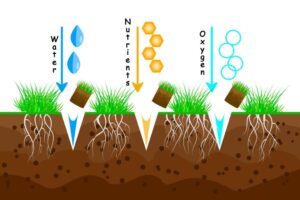
Aeration has been around for decades and has been proven time and time again to be extremely beneficial for lawns all around the world. Here at Lawn Doctor, we have performed Aerations in many different forms over the 30+ years we’ve been in business. We find it to be so important that we make sure the service continues annually for optimal results. A standard Aeration service is quick and pretty simple. Our technicians take a lap around the lawn at a steady pace on a machine, aptly called an aerator, ensuring even plugs are being pulled throughout and then disposed back onto the lawn. The replacement of the plugs back onto the lawn is pretty unsightly at first, considering your lawn will be covered with hundreds of inch-long cylinders of dirt, but is quite important- these will decompose into the soil and supply important nutrients and microbes back to the lawn. A lawn aeration may not have incredibly obvious results- you won’t see a mass green-up like with fertilizer or a curl up like with weed control- but that doesn’t mean it didn’t work! Aeration prevents soil compaction, heavy thatch buildup, and water runoff/puddling amongst other things. At the bare minimum, we recommend a lawn gets aerated at least once per year! Adding seed to the process is even better for the lawn, which is why we also offer a Core Aeration and Overseeding. This process starts out just the same as regular lawn aeration. However, once the lawn has a sufficient amount of plugs removed, the technicians will then go back around and spread seed over the lawn. These seeds get down into the holes where the plugs were pulled and lay on top of the lawn as well. This service is incredible for maintaining an already-established lawn. It provides a bit of new growth to thicken up the overall look and prevent weeds or disease from taking over the lawn.
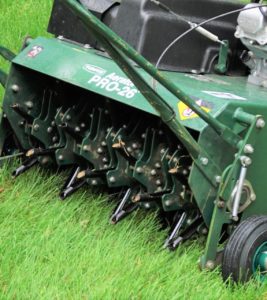
2022 brought on an upgrade for our tried-and-true method of seeding. We are now offering Double Aeration and Overseeding. The process is the same: aerate then go back and overseed, but with a bit more thoroughness for tougher areas. The technicians will consider the whole property during the service and tailor it to the lawn’s exact needs. Have a bit more compaction in some areas? Are there bare spots throughout that need some extra love? We’ll add more seed or aerate extra in the places that need it throughout the service to ensure the whole lawn is reaping all possible benefits. Following this service up with standard Aeration and Overseeding in subsequent years will ensure your lawn is always thick, green, and weed-free!
Aerating itself can be done any season, with spring and fall being the most optimal due to ideal soil conditions. Frozen ground and bone-dry soil do not make for very successful aerations, so avoid performing them in winter and summer if possible. If you choose to overseed afterwards, you’re going to have to put just a bit more thought into the timing. Aeration and Overseeding is most successful when done in the fall, usually from September through October or so. This is due to the fact that temperatures are moderate, precipitation is consistent, and weed control is hardly necessary any longer. We never recommend seeding in the spring for a multitude of reasons. To start, the ideal temperature window is much shorter, as our New England summers come up fast and furiously. Once the summer temperatures hit, if the baby grass isn’t strong enough, it will fry right out and all your efforts will have been wasted. The second reason we recommend against spring seeding is because of weeds. Pre-emergent weed control is imperative for a lawn in the springtime to ensure weeds are kept at bay all season long. Pre-emergent weed control is also a seed killer. Any seed you put down will die out very quickly if pre-emergent is applied, whether it’s done before or after, within a 90-day window. Since the springtime is already short for seeding, seeding successfully and applying pre-emergent in a timely manner just isn’t feasible.
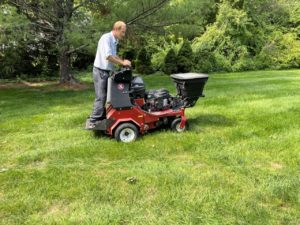 We previously mentioned a few of the benefits of lawn aeration, but there is so much more to it! First and likely the most obvious- it decreases soil compaction. This is incredibly important for a lawn’s overall health. Compacted soil prevents grass roots from getting the nutrients, air, and water they need to thrive, making new growth incredibly difficult. Removing cores from the lawn every few inches or so provides the perfect opportunity for the soil to breathe and loosen up. Aeration also prevents thatch build-up. If you don’t know, thatch is a mixture of both living and dead organic matter above the surface of the soil in a lawn. If the thatch layer is too extensive, it can welcome in a plethora of pests, diseases, and funguses. An excessive thatch layer is considered to be ½ inch thick or more, but aeration will help prevent this nasty build-up from happening.
We previously mentioned a few of the benefits of lawn aeration, but there is so much more to it! First and likely the most obvious- it decreases soil compaction. This is incredibly important for a lawn’s overall health. Compacted soil prevents grass roots from getting the nutrients, air, and water they need to thrive, making new growth incredibly difficult. Removing cores from the lawn every few inches or so provides the perfect opportunity for the soil to breathe and loosen up. Aeration also prevents thatch build-up. If you don’t know, thatch is a mixture of both living and dead organic matter above the surface of the soil in a lawn. If the thatch layer is too extensive, it can welcome in a plethora of pests, diseases, and funguses. An excessive thatch layer is considered to be ½ inch thick or more, but aeration will help prevent this nasty build-up from happening.
Also updated this year is the type of seed we apply to the lawn. In years past we’ve utilized a tri-rye blend which consisted of Kentucky Blue, Rye, and Fescue grasses. This year, however, we have upgraded to Turf-Type Tall Fescue which has provided us with incredible results so far. This blend mimics that thick, lush look that Kentucky Blue Grass provides but takes only half the time to germinate! Not only that, but it’s designed to be disease-resistant and drought-tolerant, which are both huge factors for our region in particular (hello, 2022 summer drought!). Although the cost of this seed is higher than the blend we were previously using, we always try to be sure we’re using the highest-quality products for our customers to ensure we are providing the best service possible each and every time.
